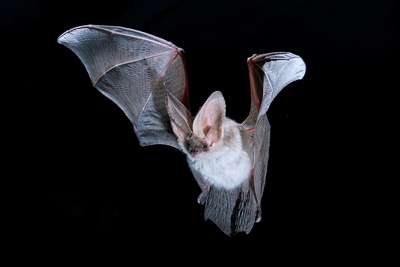The mystery of the Alpine long-eared bat

UPV/EHU researchers have studied the geographical distribution and way of life of the Alpine long-eared bat and have found that this species is of an alpine type—the only one among bats. The UPV/EHU researcher Antton Alberdi has concluded that the habitat of these bats is not limited to high mountain areas because of the climate, but because they need a rugged environment since they can live equally well in mild as well as cold climatic environments.
The alpine long-eared bat was discovered in the Austrian Alps in 2003; hence its name. Yet later on specimens were found in other milder environments as well, in Croatia, Greece and Crete, and what is more, often close to sea level. Members of the Behavioural Ecology and Evolution Group of the UPV/EHU's Faculty of Science and Technology studied the distribution and way of life of this species, and found that it forages and reproduces in mostly alpine environments (above the treeline), a unique case among bats. As the biologist Antton Alberdi explained, "the common name of the species not only refers to the place where it came from but describes its nature, too." Indeed, the researcher concluded that the resources used by the Alpine long-eared bat are the same as the ones used by alpine birds and rodents: in the Pyrenees, for example, it lives at an altitude of between 1,500 and 2,500 metres and hides under rocks, in crevices and on ledges.
Nevertheless, how is it possible that an animal that only lives above 1,500 metres in the Pyrenees can be found at sea level in Croatia? Alberdi was involved in seeking the answer to this question in his PhD thesis. Alberdi identified and quantified the environmental conditions that determine the distribution of the Alpine long-eared bat (Plecotus macrobullaris) to try to understand why this species is restricted to mountain environments and why it can appear at sea level at the same time. After that, in order to see whether the results obtained could be extrapolated to other species, he compared the distributions of 503 vertebrates with those of the bats, and found five vertebrates that have similar geographical distributions to that of the bat: the white-winged snowfinch, the Alpine chough or yellow-billed chough, the wallcreeper, the Alpine accentor and the European snow vole. The distribution of all of them is very broad, from Western Europe all the way to Asia, but they are restricted to the main mountainous areas. He studied their ecological features to see whether they were all following a common biogeographical pattern in order to work out whether they were following a common distribution model.
They need rugged places
The basic ecological features of these vertebrates and those of the Alpine long-eared bat are very similar: they all use rocks (crevices, ledges or crushed stones) as places to hide, and they need open spaces to forage. They have also seen that they can be found in cold mountain environments (in the Alps) as well as in hot ones (in the mountains of Iran and Syria, etc.) and that suggests that the reasons that restrict these species to mountainous areas are not climatic ones: they are linked to topography. In other words, they are not in mountainous areas because they cannot withstand a hot environment, but because high mountain habitats offer them the characteristics they need. In some cases, in Croatia, for example, these conditions can be found at lower altitudes, and that explains why the species can be found at sea level. Furthermore, as they have the capacity to withstand the cold, they can use the alpine habitats that other species cannot exploit and thus avoid competition. In any case, "it cannot be said that the climate does not exert any influence," said the researcher. "In fact, the climate determines the altitude ranges that each species can live in."
According to the researcher, to preserve the species it is essential to know everything about them: how they live, why they are present in the places where they are present, etc. In the case of these species, therefore, climate change will not exert such an effect in the future; "more attention will need to be devoted to other factors: human exploitation, pasture use, etc.," he explained. The researcher believes that the rise in treelines taking place as a result of the decline in the pressure of livestock will affect these species most. Indeed, as the treelines recede, the surface area suited to the habitats of these species will be reduced, because other species will also recede and that way the pressure will increase. They are now working to quantify that effect.
More information: A. Alberdi, J.R. Aihartza, O. Aizpurua, I. Garin (2014). "Unveiling the factors shaping the distribution of widely distributed alpine vertebrates, using multi-scale ecological niche modelling of the bat Plecotus macrobullaris". Frontiers in Zoology 11:77.
A. Alberdi, J.R. Aihartza, O. Aizpurua, E. Salsamendi, R.M. Brigham, I. Garin (2014). "Living above the treeline: roosting ecology of the alpine bat Plecotus macrobullaris". European Journal of Wildlife Research. DOI: 10.1007/s10344-014-0862-8.
A. Alberdi, I. Garin, O. Aizpurua, J.R. Aihartza (2013). "Review on the geographic and elevational distribution of the mountain long-eared bat Plecotus macrobullaris, completed by utilising a specific mist-netting technique". Acta Chiropterologica 15(2): 451-461.
A. Alberdi, I. Garin, O. Aizpurua, J.R. Aihartza (2012). "The foraging ecology of the Mountain long-eared bat Plecotus macrobullaris revealed with DNA mini-barcodes". PLoS ONE 7(4): e35692.
Journal information: Frontiers in Zoology , PLoS ONE
Provided by University of the Basque Country



















